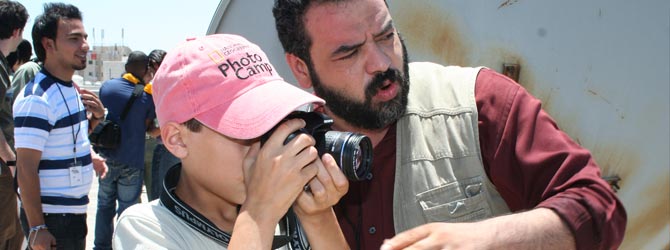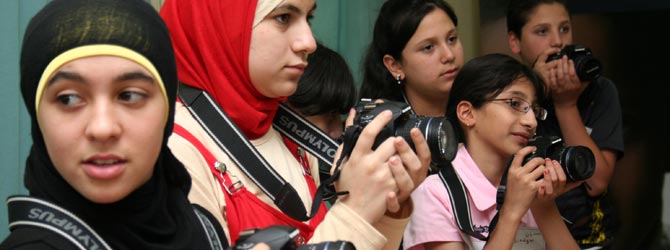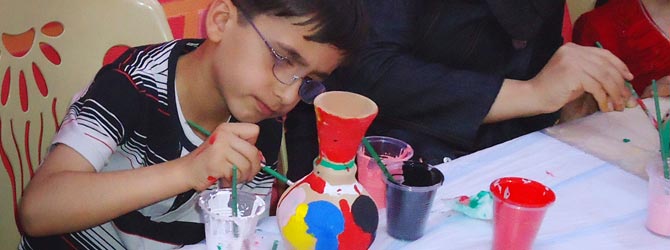Using Art in Emergencies
For communities exposed to war, natural disaster, and disease, art and creative expression can become a powerful tool in helping them deal with the emotional wounds left behind. It can also be used as an education tool that can change behavior, such as stopping sexual violence or promoting healthy habits.
International Medical Corps often integrates art, including photography, painting, drawing, theater, and dance, into its programs across the globe, to help people – especially children and youth – recover from difficult events and to engage communities.




Art Exchange between the U.S. and Japan
When students at Ridge Elementary School in New Jersey, learned about the March 2011 earthquake and tsunami that devastated much of northeastern Japan, they began to draw pictures for the children in communities impacted by the disaster. International Medical Corps assisted in connecting Ridge Elementary with a school in Kesennuma City, Japan and presented more than 200 drawings to Japanese elementary school students in Japan.
Emi Samata, International Medical Corps’ Logistics Officer in Japan, described the children as “unbelievably energetic,” and was surprised that even in the aftermath of such a disaster, they were delighted by the American children’s drawings. Samata presented each of the students of Kesennuma City with new crayons and paper, asking them to draw something in return for their American counterparts.
The children jumped at the opportunity. Some thanked Ridge Elementary’s students in English, while others drew fish to represent life in Kesennuma City, which was once a busy fishing port before the tsunami. Many of these students are coping with the death of loved ones, unemployment of their caretakers, and devastation of their property. Through this art-based exercise, the children of Japan affected by the events of March 2011 were given an opportunity to express their identity as a community, recognize their losses and begin to rebuild with the support of their new American friends.
One Japanese boy wrote on his drawing to a New Jersey student: “Thank you for the support. I’ll do my best.”
Art and Media in the Democratic Republic of Congo
Through the Care, Access, Safety, and Empowerment (CASE) program International Medical Corps has established art-based activities in community centers in the Democratic Republic of Congo (DRC). Through group-based psychosocial programming, community members can participate in therapeutic activities that help facilitate recovery from violence and promote social cohesion. The activities range from community-wide offerings to those specifically targeted at demographic groups, such as women and youth. These programs bring the community together and help to prevent and address gender-based violence (GBV) by reducing stigma faced by survivors and discussing the perceptions and behaviors that contribute to GBV.
International Medical Corps supports Behavior Change and Communication (BCC) projects in DRC that aim to address social norms and modify negative behaviors in Eastern DRC through education and psychosocial programming. In DRC, art-based programs like traveling theater addresses concerns raised by the community, including themes such as GBV and the status of women in society, and facilitates a dialogue about sensitive cultural issues.
As part of BCC, International Medical Corps also partnered with local musicians like Fikiri Dadugu, an outspoken proponent of gender equality and human rights. Through such partnerships, International Medical Corps intends to utilize the influence of music in the lives of young people of the community in order to sensitize them on sexual violence and promote positive attitudes and behaviors regarding gender relations and the treatment of GBV survivors.
Photo camps in Uganda and Jordan
International Medical Corps partnered with National Geographic to implement Photo Camps in both Uganda and Jordan for refugee and displaced children affected by conflict. Most of the children who participated in the program had witnessed violence, lost loved ones, and homes – many had experienced feelings of distress, anxiety and sadness. As part of the program, world-renowned National Geographic photographers taught the children how to take photographs of their environment, while International Medical Corps staff worked with the children to discuss the images they had captured and in turn tell the story of what they saw through their own lens. Photography proved a powerful tool in helping children articulate how they see the world and create something meaningful to be shared with their families and communities.
The Photo Camp in Uganda was comprised of young refugees of war in the Democratic Republic of Congo, Rwanda, and Sudan; many were orphans, none had ever held a camera. Through photography, the children were able to show for others the refugee life they experience, and convey the depth of their difficult circumstances as well as beauty and resilience. In Jordan, Iraqi and Palestinian refugees, as along with at-risk Jordanian youth, were taught how to describe their personal world and create self-portraits.
Following both Photo Camp projects, the children’s images, accompanied by captions in their own words, were exhibited in their communities and in galleries around the world so that their experiences could be shared with a wide audience.
Children’s Camps in Haiti
On International Women’s Day, International Medical Corps hosted a children’s camp at its primary health care clinic in the Petionville Club displacement camp. With sexual and gender-based violence on the rise in Haiti’s displacement camps, International Medical Corps used the camp as an opportunity to teach children about their rights and boundaries, and then gave them an opportunity to express themselves, and stand up against violence, through art. Children painted murals and performed dances and skits to convey their feelings towards and experiences with sexual and domestic violence.